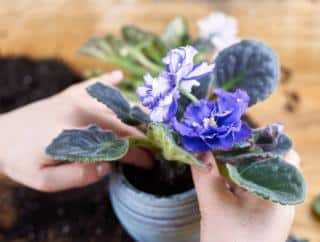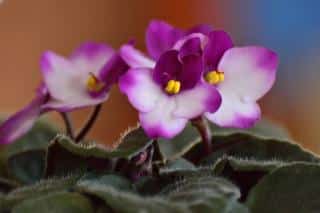

African violet is one of the most sold indoor plants the world over.
Key African Violet facts, a list
Name – Saintpaulia ionantha
Family – Gesneriaceae
Type – indoor plant
Height – 8 to 12 inches (20 to 30 cm)
Exposure – veiled
Foliage – evergreen – Flowering – all year round
Its blooming can last for most of the year, sometimes even all year round for some violets!
African violet likes a tight fit in its pot and thus doesn’t need to be repotted immediately.
After that, every 2 or 3 years and preferably in spring, repot your African violet in a pot of a very slightly larger size.
Repotting African violet
 Surrounding temperatures must be lower than 60°F (16°C) to ensure proper settling in.
Surrounding temperatures must be lower than 60°F (16°C) to ensure proper settling in.Propagation is possible in spring with cuttings.
The best location for your African violet is in a spot where there isn’t any direct sun on the plant, ever.
 African violet can’t stand the sun’s rays when they touch its leaves directly.
African violet can’t stand the sun’s rays when they touch its leaves directly.African violet requires temperatures that oscillate between 65 and 74°F (18 to 24°C) and which never drops below 57°F (-13°C). Ideally, the daily cycle is 4 to 5 degrees cooler at night.
You can put gloxinia in the immediate vicinity of this plant because they both share the same growing conditions.
Regular but moderate watering is called for. African violet requires little water.
In spring and summer
Keep the soil mix a bit moist and check that water drains properly.
Provide flower plant liquid fertilizer more or less once a month to extend the blooming to the max.
To retain a certain moisture level, it is best to put the pot on a bed of clay pebbles with water at the bottom.
In fall and winter
Reduce watering and wait for the soil to be thoroughly dry in the surface before watering again.
Stop adding fertilizer.
Most diseases targeted are the typical indoor plant diseases, red spider mite, scale insects, aphids and also powdery mildew.
African violet or Cape violet was discovered in 1892 by Baron Walter Von Saint-Paul in the mountain ranges of Tanzania.
The name “Violet” was given to it because it is very similar to the viola violet, but there is otherwise nothing in common between the two plants.
Read also: